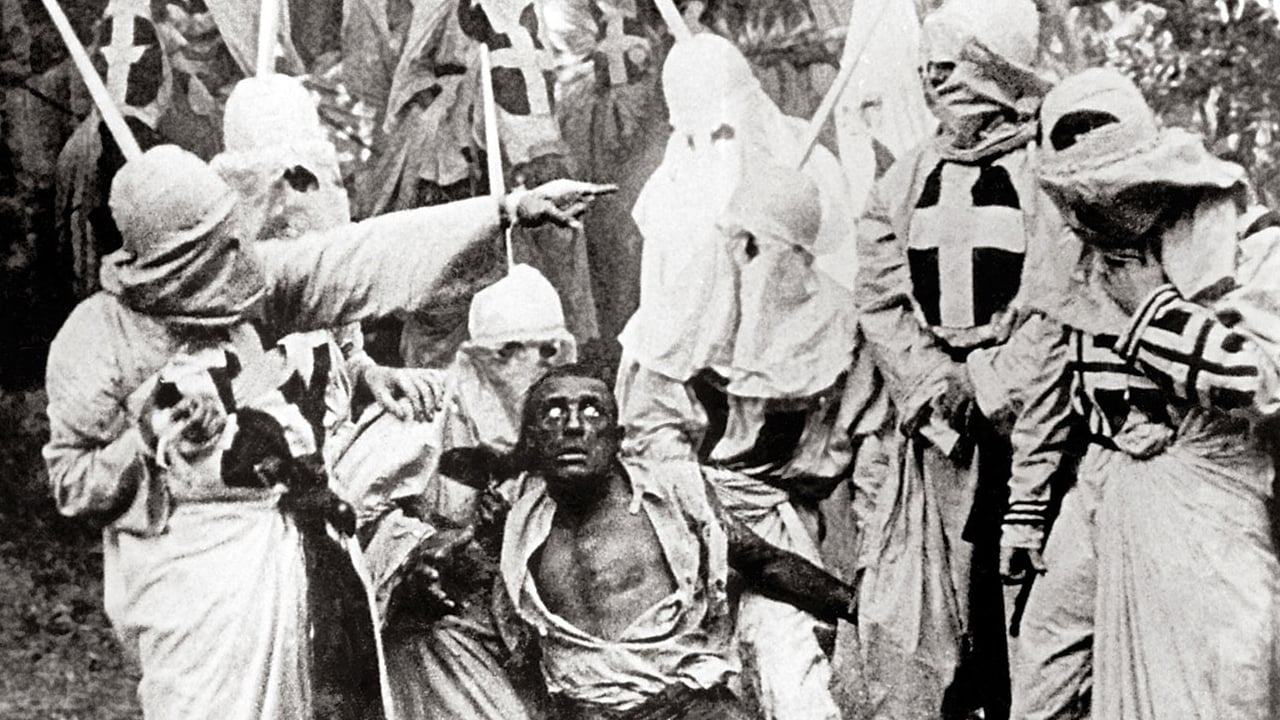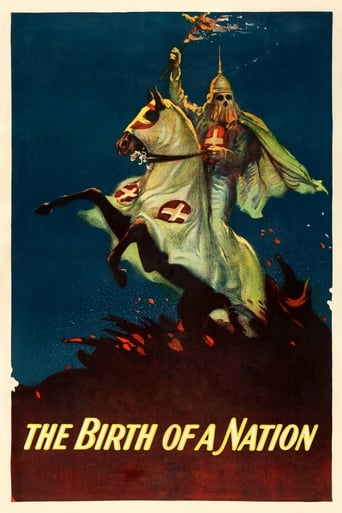

As the title suggests the Klan were heroes and this is a great movie :)
... View MoreIt was good during the civil war part. I liked the big battle scenes and the story during that part was interesting enough and everything, but then the second half started and I thought at first maybe the director was going for something that was actually pro-rights for African Americans but then I noticed all the black face, and then the story takes a much darker tone that really wasn't necessary, accurate, and came from a place of ignorance. I know it was a different time, but as the highest selling silent movie of all time, I guess I was expecting something, you know...less racist. Anyway, I guess that shows you that controversy sells tickets, if nothing else.
... View MoreIs this film politically incorrect? Absolutely. Was it influential? Yes. Is it historically inaccurate? For the most part, yes. Film is considered art and art has always been considered controversial. This was the first film to gain significant controversy and it wouldn't be the last. The film saying that all blacks are murderers and rapists is no different than Donald Trump saying all illegal immigrants are murderers and rapists. This film came out in 1915, Donald Trump made that controversial statement in 2016, 101 years later. Things clearly haven't changed. You need to be aware that this film is racist or else it might be a bad influence on you. Yes, the movie does portray the KKK as heroic, it does make it seem all blacks are vicious rapists, but I don't believe in banning this movie because it would be the same as trying to pretend this kind of racism and racial prejudice never existed. It should be shown so people can learn from the past and never make those same mistakes again. As for the black face makeup, that was sadly a product of its time, most black characters in movies back then were portrayed by white actors wearing black face paint, it was racist back then and it's racist now. Even though it was politically incorrect, there was no film like this at the time in terms of production and editing. It was the first time people began to take a motion picture seriously. The movie was seen as a book in moving pictures full of drama, excitement, romance and heartbreak. It's just unfortunate one of the most influential movies in history also happens to be the most controversial. If you are aware that this film is nothing but anti-black propaganda, then this movie probably won't turn you into a racist. Almost every open minded person knows that the KKK is a horrible organization that should have never existed. But you should appreciate this movie more for its art and production rather than its message. There's been plenty of other stories with bad messages. Grand Theft Auto V is a video game about trying to become a successful criminal and that game has sold extremely well. This movie should only be seen by those mature and open minded enough to know how racist it is. It shouldn't be seen by a young mind who doesn't know right from wrong.
... View MoreThe recurring criticisms towards the film's portrayal of racism oftentimes include the use of black-face makeup on white actors, the limited portrayal of black people being shown in a negative and sexually aggressive manner, historical inaccuracies to favor the South's point of view, and the glorification of the KKK. Black-face makeup is an arguably racially insensitive makeup tool generally used by white actors to portray black characters. Similar makeup techniques were used in classics like Lawrence of Arabia, Touch of Evil, and Breakfast at Tiffany's where white actors are in different colors of makeup to portray characters of other races. Black-face was less a fault with the film as much as it was an unfortunate fault with the era in film and the lack of job opportunities in America for black people at the time. Black-face was a tool within the film that reflects the time frame that was still plagued with its racially unfair history. There are several notable characters that represent African- Americans as either being saintly by obeying their white southern masters, or the opposite by carrying out their violent and sexually aggressive behavior. While the latter statement is only really applied to one represented character on screen, most of the black characters are either neutral or as mentioned otherwise, this scene can be quite problematic. This is due to what one perceives the film as implying, as one can argue that this indicates that black people are generally like this. On the subject of stereotyping, people suggest the scene involving a black man attempting to rape a woman, who jumps off a cliff to her death, unfairly implies that black men generally behave that way. It is not fair to apply stereotypical attributes, whether they stem for partial truths or not, upon everyone within a culture. The sexually aggressive rapist character triggers others in the film to unfairly associate the individual's qualities with his race. The film clearly depicts racism but is not necessarily condoning it. Furthermore, the exaggerated attributes of the mentioned character are technically held to the same standard as most of the significant characters within the film. Silent films are known for exaggerated performances to heighten drama.A constant criticism is that it is morally wrong as its narrative is from a racist viewpoint. Beloved films consistently portray stories and themes from the perspective of evil. People consistently accept films depicting murder and other crimes, shamelessly told from the perspective of said criminal. Goodfellas depicts evil behavior in the form of organized crime, as seen from the perspective of someone who is and likes being a gangster. One can say the film does not promote such themes, but technically it never directly states it isn't. The lead character frequently and directly voices his disgust for regular lifestyles to the audience, while commenting on how superior his way of living is. Scorsese leave it up to the viewer's perception to interpret right from wrong, mostly with success. Goodfellas' depiction of violence theoretically could be mirrored with this film's depiction of racism as both display evil from characters' viewpoints who argue for it; and without an observable argument against such behavior, the audience can perceive right from wrong themselves. However, this can't be fully compared, as the film does provide a clear distinction. The film does not condone racism, from my perspective. Like Goodfellas, it depicts heinous acts and includes characters blatantly arguing for a certain evil lifestyle; although, unlike Goodfellas, The Birth of a Nation includes direct statements heavily suggesting the evil content depicted is not necessarily promoted by its creators. At the start of the film is an inter-title that reads: is blatantly stating its intentions that are not to offend with improprieties and obscenities. Griffith previously made a film depicting the KKK as the enemy. Griffith, makes a test to his audience, albeit unknowingly, and their discernment of how differences in camera movement and editing can imply heroism to an individual. Griffith argues that one must first understand evil and darkness, to understand and embrace its opposite. With such free speech, he demands the right to show whatever he sees necessary in the depiction of this historical event.One can argue that such beloved films about criminals are acceptable to argue for and rationalize immoral behavior, when there is a logical explanation for such behavior. For example, a character decides to rob a bank for his/her sick spouse, and decides to kill people along the way. Point A leads to Point B. Indeed, there is a motive, but it does not make the violent behavior right. This logic can be applied to the film. Racism increases due to events including the scene mentioned above. Point A leads to Point B. There can be reasons for immorality, but justification is not necessarily acceptable. I believe this film is not held to the same standard as other films that technically deal with similar potential issues. One may argue that racism is not greater in immorality levels than other crimes depicted in films, yet many beloved western films reinforce racism towards Native Americans. Interestingly, nine years prior to the controversy and multiple bans of the film for its alleged racist agenda, the 1906 film Reenactment of the Massacre at Wounded Knee was banned in the US for its sympathetic depiction of Native American people.The glorification of the KKK is constructed by the perception of the film's viewers. It does not appear that the film is condoning the group's agenda; even if the film was doing so, it is a double standard to find this inappropriate and dismissing it, but defending crime films arguably condoning crime and violence, and western films arguably condoning racism towards Native Americans. Now, there are those who do not accept any form of rationalization for evil in free speech, which is reasonable.
... View More